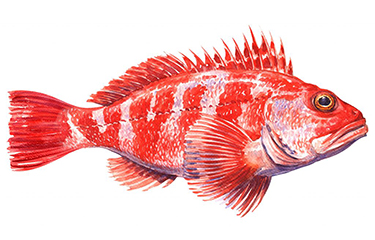Maine lobsterman have gained a new option for baiting their traps as Cooke Aquaculture USA has secured permission from the state’s Department of Marine Resources to process and use whole blackbelly rosefish as lobster bait.
The new bait comes as the fishery’s main source of bait, herring, has faced a significant cut to quotas in 2019 and potentially beyond. The New England Fishery Management Council elected to slash the herring quota from nearly 50,000 metric tons (MT) to just over 15,000 MT – a 70 percent reduction – in the wakes of biomass surveys that indicated substantial declines in recruitment and biomass of the fish.
That quota cut means the lobster industry has to go without roughly 55 million pounds of bait in 2019; and the management council may cut quotas further in 2020 and 2021.
“Lobstering is an important part of the communities where we operate. Lobster fisherman are our friends, neighbors, and in many cases, family,” Glenn Cook, CEO of the Cooke Inc. family of companies, said in a release. “When we learned about the bait shortage and its impact on the lobster industry in Maine, we began to explore possible solutions.”
Finding a new bait for the fishery isn’t as simple as shipping in a new fish. The state of Maine has strict requirement for what species can be used as bait, and where it can be sourced from.
According to Jeff Nichols, the director of communications for the Maine DMR, the process is started off with a form before any potential bait goes through a review process.
“They submit that request form, and then there is a review done by a bait review team. That is primarily a literature review to make a determination around pathogens and potential invasive species associated with the particular resource that’s being requested,” Nichols told SeafoodSource. “The commissioner makes the ultimate decision.”
Each species is reviewed for potential pathogens or genetic concerns when compared to local species. A species that is native to the region, for example, is easier to approve than a species that does not occur naturally in the area.
“Each species, each petition that’s submitted is evaluated on its own merits, and if there is any efficiencies to be had, those will be considered,” Nichols said. “They do a very thorough literature review on each petition, there are no shortcuts. There’s a real commitment to a rigorous review for the biosecurity of the marine environment. That’s why we have this process.”
A great example of the state’s commitment to the process is the efforts to use invasive silver carp, which has taken over several rivers and lakes in the U.S. That bait has been delayed for use by the Maine DMR commissioner Patrick Keliher out of concerns about pathogens.
“The commissioner made a decision to actually delay a decision on that particular bait because what he wants to do is have testing done during colder months of the year,” said Nichols.
A pathogen, viral hemorrhagic septicemia, can be found on the fish. That virus is typically more active during cold weather, so the Maine DMR is waiting to do testing in the fal.
“He wanted to ensure that we’re testing during a time of year when the potential for it to be prevalent is higher,” Nichols said of the commissioner’s decision.
In contrast to invasive silver carp, Cooke Inc. had a bit of a leg up with whole blackbelly rosefish, according to Joel Richardson of Cooke.
“It’s from the same scientific classification as the Atlantic redfish, it's very close,” he told SeafoodSource. “It wasn’t found to be introducing a different species, it's very similar.”
The fish is commonly found off of Uruguay, and is often caught as bycatch during some of Cooke’s operations in the area.
“We fish hake and red crab there, and we have a wild caught operation there for those two species,” Richardson said. “This species is found in that area quite abundantly.”
The species will be frozen at sea within a few hours of being caught, before being transported to Maine. According to Richardson, the company will have sufficient volumes of the fish to support the industry, and the company is working on the distribution channels needed to get the bait into the hands of the industry.
“Then it would be supplied to bait dealers in the area. Some of those details are being worked out, because it's [rosefish] just been approved at the end of June,” Richardson said. “We’re working on establishing those relationships with them.”
Patrice McCarron, the executive director of the Maine Lobstermen’s Association, said that new sources of bait are always welcome.
“We've been working hard to bolster the bait supply, and every new bait source helps,” she told SeafoodSource. “Baits like blackbelly rosefish and Gulf of Mexico menhaden should be available at volumes that will help fill our bait gap.”
For now, the bait supply issue hasn’t been impacting the state’s fishery too adversely, she said.
“Due to an extremely cold and wet spring, the fishery is off to a slow start,” McCarron said. “The MLA hope's that having these new bait sources available will help ease the strain as the season picks up.”







